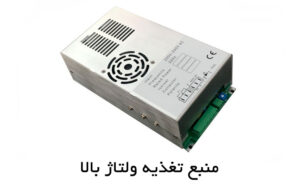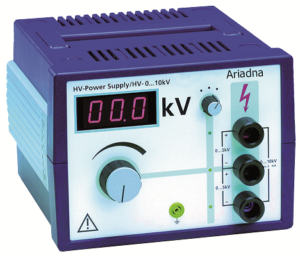high voltage Power Supply
A high voltage power supply is a device that accepts standard mains electricity—either single-phase or three-phase (and, in rare cases, battery power)—as its input.
By routing this input through various power and electronic circuits—such as primary transformers, voltage multiplier stages, high voltage transformers, and switching circuits—it generates a high output voltage exceeding 1,000 volts.
In simple terms, a high voltage power supply is a device designed to generate voltages above 1,000 V. This output voltage can be either direct current (DC) or alternating current (AC).
🎥 Instructional Video
Testing a 10,000-volt high voltage power supply (an electric arc is visible at the moment of activation):
high voltage (and high-power) power supply current draw test:
⚙️🔧 Design and manufacturing of high voltage power supplies in AC and DC modes, from 10 kHz frequency up to 100 kW power.

For inquiries about high voltage power supplies, please contact us.
| Design & Manufacturing Capabilities | Specifications |
|---|---|
| Input Power | Single-phase | Three-phase |
| Design Architecture | Fully switching-based with efficiency >83% (or low-power transformer-based design for lower cost) |
| Cooling System | Fan-cooled | Liquid-cooled (circulating water) |
| Automation Capability | Windows Software | 7-inch PLC HMI |
| Output Type | AC | DC | Pulsed |
| Communication Interfaces | Remote Control | RS485 | Ethernet | MODBUS | RS232 |
| Voltage Range | Adjustable from 1 V up to 200 kV (constant or variable) |
| Power Rating | Customizable up to 100 kW |
| Polarity | Positive | Negative |
| Output Pulse Waveform | Sinusoidal | Quasi-sinusoidal | Square |
| Output Pulse Frequency | 10 kHz to 200 kHz |
| Pulse Duty Cycle | 5% to 95% |
| Output Safety | For enhanced safety, positive and negative outputs are isolated | Three-terminal configuration: Positive, Negative, and Ground |

Before introducing the high voltage power supply, we aim in this article from Ariadna Sanat to explore the role and importance of power supplies.
The power supply is considered the most essential component of any electrical circuit. Its primary function is to provide a stable current or voltage for use in various parts of the circuit. To inquire about power supply pricing or to order a custom power supply, feel free to contact us.
Power supplies are either current-type or voltage-type, though voltage-type power supplies are predominantly used in electrical and electronic applications.
high voltage power supplies are designed and manufactured according to the specific requirements of electrical systems and circuits.
Read more: Key Considerations When Purchasing a Variable Power Supply
Further Details on high voltage Power Supplies (HVPS)
A simple DIY high voltage power supply demonstration for enthusiasts
Description:
### Circuit Components:
– Low-voltage DC input (battery)
– Oscillator
– Step-up transformer
– Voltage multiplier stage (diodes and capacitors)
– high voltage capacitor with high capacitance
The input to this circuit can be a fixed DC voltage of 12 V or 24 V, and the output is a high voltage power supply. The low-voltage DC input first enters an oscillator, which then drives the primary side of the transformer. As a result, a square or pulsed waveform appears across the primary winding of the transformer.
Since the transformer is a step-up transformer, a high voltage AC signal is generated on its secondary winding. This high voltage AC then feeds into the voltage multiplier circuit, which performs both rectification and further voltage amplification.
Each stage of the voltage multiplier consists of one diode and one capacitor. The voltage contributed by each stage equals the peak output voltage of the transformer secondary. Therefore, the final output voltage is:
Final Output Voltage = (Transformer Secondary Peak Voltage) × (Number of Multiplier Stages)
high voltage power supplies are manufactured for various output voltage levels, and some models offer adjustable output within a specific range. One of the most critical characteristics of a high voltage power supply is its ability to maintain a stable output voltage despite changes in load.
However, every power supply has a specified maximum current rating, determined by the manufacturer based on the customer’s requirements. If the load demands more current than this rated value, the supply will either limit the output current or experience a voltage drop.
Additionally, when purchasing an AC high voltage power supply (link), note that maximum output power is achieved at the resonant frequency of the system. Deviating from this frequency may result in reduced output power.
high voltage power supplies are a specialized category of power sources designed to deliver the high voltages required by specific applications—such as plasma generation, X-ray tubes, electrostatic systems, and more.
> Note: In power electronics, any power supply with an output voltage exceeding 1,000 volts (1 kV) is generally classified as a high voltage power supply.
Suggested article: Industrial Switching Power Supply
high voltage Applications
Many industrial devices and systems—particularly in fields such as medical technology—require high voltage power to operate.
In the past, high voltage power supplies were bulky, heavy, and time-consuming to maintain and install.
Thanks to advances in power electronics, modern high voltage power supplies are now significantly smaller, lighter, and deliver far superior voltage quality compared to older models. This evolution has made operating such equipment much easier, more affordable, and more accessible.
At Ariadna Sanat, our engineering team is committed to designing custom high voltage power supplies with the smallest possible footprint and the highest efficiency, tailored specifically to your industrial needs.
Don’t miss this article: Oil Cracking System

Applications of high voltage Power Supplies
high voltage power supplies are widely used across numerous sectors, including scientific research, ozone and plasma generation, oil & gas, petrochemicals, pharmaceuticals, cosmetics, food processing, agriculture, and environmental technologies.
Additional key applications include medical and therapeutic devices, textile and fiber manufacturing, and both gas and solid-state lasers. One of the most significant uses is in ozone generation for air and water purification.
These power supplies also support a broad range of critical applications, such as:
- Semiconductor fabrication equipment
- Plasma power supplies
- Vacuum generation systems
- Medical devices
- X-ray tube excitation
- Electrostatic induction
- Ion filters for removing harmful gases
- Dielectric strength testing
- Ion and electron accelerators
- Electron guns
- Radiation detectors
- Electrostatic painting/coating
- Long-distance power transmission
- Insulation testing of power equipment
- high voltage air purifiers
- Pharmaceutical processing equipment
- Electrospinning systems
- Electron beam generation in microscopes
- Water and food processing systems
- Lithography
- Nuclear detectors
- Waste recycling systems
- Plasma sterilization systems
